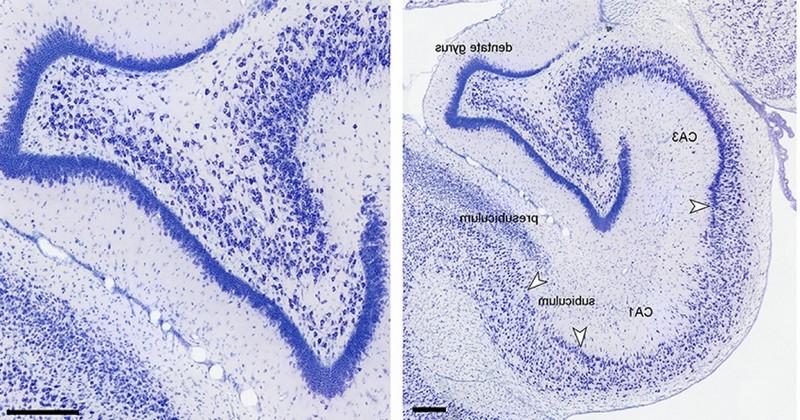Dentate gyrus: what is it and what functions does it play in the brain?

This small brain structure may be the only one in which new neurons are always being born.
Our cerebral cortex is a complex structureOur cerebral cortex is a complex, extremely developed structure that allows us to perform and coordinate the various functions and actions that our organism can carry out, both physically and mentally and in terms of both perception and action.
But this structure is not homogeneous: different brain areas specialize in different functions, with certain parts of the brain being more relevant to certain mental processes. An example of this is the dentate gyrusof great importance in the formation of memories, which we are going to talk about in this article.
What is the dentate gyrus?
We call the dentate gyrus a gyrus of the cerebral cortex located in the inferior part of the temporal lobe of the brain, being part of one of the oldest phylogenetically speaking regions of the cortex (the archicortex). of the brain, being part of one of the oldest phylogenetically speaking regions of the cortex (the archicortex). It borders, among other structures, the corpus callosum (although it is separated from it by the indus gracilis), the entorhinal cortex, the hippocampus and the cingulate gyrus.
This small brain region is part of the hippocampal formation, connecting it with the cortex, and is mainly made up of gray matter (somas and amyelinic axons). In fact, it is considered that this gyrus considered to be a modified and partially separate part of the hippocampus itself during neurodevelopment. during neurodevelopment.
Thus, this part of the cortex plays an important role in the memory capacity of the human being, acting as a bridge between the entorhinal cortex (which in turn is considered a bridge between the hippocampus and the rest of the cortex) and the hippocampus. This structure acts by receiving afferents from the former and sends information to the rest of the hippocampal formation, passing through the dentate gyrus via the perforant pathway. However, its connections with the entorhinal cortex do not allow the return of information through the same channel. It will be other structures that send the information back to the entorhinal cortex so that it can be distributed to other parts of the cortex.
The dentate gyrus has the particularity of being mainly formed by granulosa cells. mainly formed by granulosa cellswhich in their axonic terminations end up transforming into mossy fibers that synapse exclusively with the hippocampal ammon field. In addition, these cells are among the few that can generate new neurons throughout the life cycle in certain types of mammals (it is not yet known whether this also occurs in humans).
Functions
The functions of the dentate gyrus, as mentioned above, derive in large part from its role as a connection between the entorhinal cortex and the hippocampus.. Thus, one of its main roles is to transmit information to the latter structure in order to be able to process it.
The dentate gyrus thus has an important role in the formation of memories, based on episodic memory. It is also of great importance for navigation and spatial memory, being this structure the one that allows us to distinguish between similar environments.
It also plays a role in memory consolidation and retrieval.The hippocampal formation is also part of the limbic system, and it is suspected that the dentate gyrus also plays a role in the integration into the memories of emotions elicited by experience.
As the hippocampal formation is also part of the limbic system, it is suspected that the dentate gyrus also plays a role in the integration of the emotions aroused by the experience in the memories. It has also been observed the existence of variations in this area in the presence of emotional disturbances such as stress or anxiety, as well as depression.
The birth of neurons in adults
Traditionally, it has always been said that the formation of new neurons occurred only in the first years of life and that once in adulthood we had approximately the same neurons for life until they died. However, over time it has been discovered that in some mammals, although not at a generalized level, some areas of the brain continue to produce, in small quantities, new neurons throughout the life cycle.
One of the points where this neurogenesis has been detected is the dentate gyrus. This birth has been found to be associated with task learning and spatial learning, which, in turn, appear to enhancewhich in turn seem to promote the birth of new neurons. However, studies on this subject have not been able to demonstrate that neurogenesis generates an improvement in these capacities, with contradictory results (although this could be due to the need to develop strong synapses between the new neurons). More research is needed in this area,
It has also been observed that the environment has great importance in the formation of new neurons: stress or cholinergic lesions diminish the capacity to generate new neurons, while stimulation enhances it. The observation of alterations in neurogenesis in this area is one of the main reasons that have led to think about the involvement of the dentate gyrus in the management of emotions, whether this alteration of neurogenesis is a cause or a consequence.
Bibliographical references
- Nieto-Escámez, F.A.; Moreno-Montoya, M. (2011). Neurogenesis in the hippocampal dentate gyrus: implications for learning and memory in the adult brain. Arch. Neuroscien., 16 (4): 193-199.
- Andersen, P.; Morris, R.; Amaral, D.; Bliss, T. & O'Keefe, J. (2006). The hippocampus book. 1st Edition. OUP. USA.
- Clark, D. L.; Boutros, N. N. & Mendez, M. F. (2012). The brain and behavior: neuroanatomy for psychologists. 2nd ed. El Manual Moderno. México.
(Updated at Apr 12 / 2024)